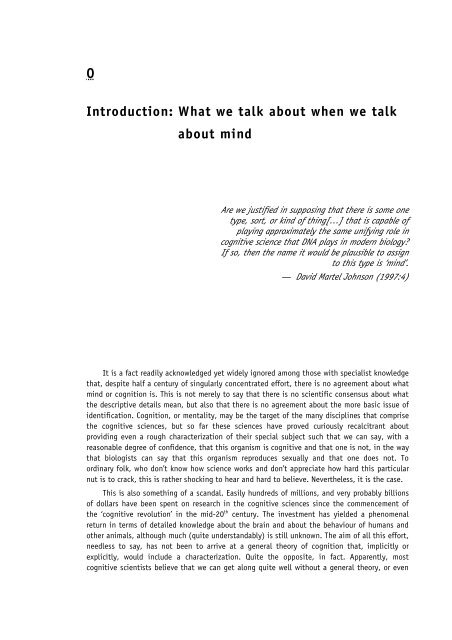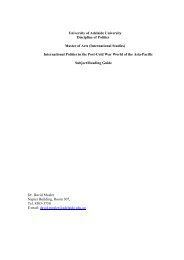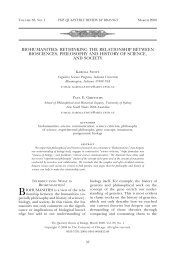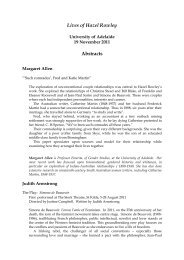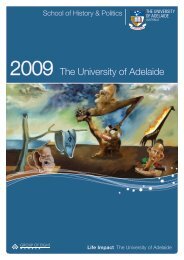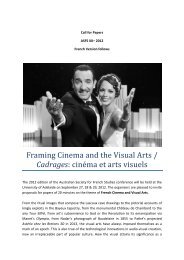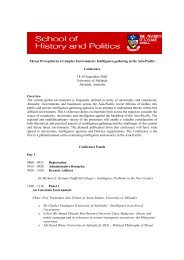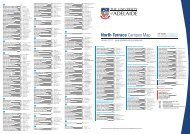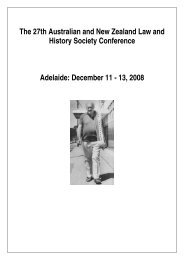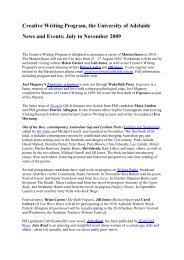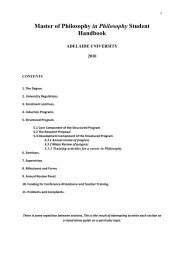Introduction - Faculty of Humanities & Social Sciences
Introduction - Faculty of Humanities & Social Sciences
Introduction - Faculty of Humanities & Social Sciences
Create successful ePaper yourself
Turn your PDF publications into a flip-book with our unique Google optimized e-Paper software.
0<br />
<strong>Introduction</strong>: What we talk about when we talk<br />
about mind<br />
Are we justified in supposing that there is some one<br />
type, sort, or kind <strong>of</strong> thing[…] that is capable <strong>of</strong><br />
playing approximately the same unifying role in<br />
cognitive science that DNA plays in modern biology?<br />
If so, then the name it would be plausible to assign<br />
to this type is ‘mind’.<br />
— David Martel Johnson (1997:4)<br />
It is a fact readily acknowledged yet widely ignored among those with specialist knowledge<br />
that, despite half a century <strong>of</strong> singularly concentrated effort, there is no agreement about what<br />
mind or cognition is. This is not merely to say that there is no scientific consensus about what<br />
the descriptive details mean, but also that there is no agreement about the more basic issue <strong>of</strong><br />
identification. Cognition, or mentality, may be the target <strong>of</strong> the many disciplines that comprise<br />
the cognitive sciences, but so far these sciences have proved curiously recalcitrant about<br />
providing even a rough characterization <strong>of</strong> their special subject such that we can say, with a<br />
reasonable degree <strong>of</strong> confidence, that this organism is cognitive and that one is not, in the way<br />
that biologists can say that this organism reproduces sexually and that one does not. To<br />
ordinary folk, who don’t know how science works and don’t appreciate how hard this particular<br />
nut is to crack, this is rather shocking to hear and hard to believe. Nevertheless, it is the case.<br />
This is also something <strong>of</strong> a scandal. Easily hundreds <strong>of</strong> millions, and very probably billions<br />
<strong>of</strong> dollars have been spent on research in the cognitive sciences since the commencement <strong>of</strong><br />
the ‘cognitive revolution’ in the mid-20 th century. The investment has yielded a phenomenal<br />
return in terms <strong>of</strong> detailed knowledge about the brain and about the behaviour <strong>of</strong> humans and<br />
other animals, although much (quite understandably) is still unknown. The aim <strong>of</strong> all this effort,<br />
needless to say, has not been to arrive at a general theory <strong>of</strong> cognition that, implicitly or<br />
explicitly, would include a characterization. Quite the opposite, in fact. Apparently, most<br />
cognitive scientists believe that we can get along quite well without a general theory, or even
Introdu ctio n 2<br />
that a general theory may not be possible, which is why the issue has languished at or near the<br />
bottom <strong>of</strong> the agenda. The upshot is that new empirical findings about the brain and behaviour<br />
are being churned out at a truly staggering rate and in fine detail, but there is no framework for<br />
making sense <strong>of</strong> them.<br />
We speak confidently <strong>of</strong> the mind as the brain—<strong>of</strong>ten hyphenated nowadays as ‘mindbrain’—but<br />
this tells us virtually nothing about what cognition is and what it does. The brain<br />
controls almost everything in the body. In the end the putatively 'physical' parts <strong>of</strong> the brain<br />
and the putatively 'mental' parts may not really be all that separable. Well-reasoned ideas<br />
abound about cognition: as computation, representation, information processing, or the engine<br />
<strong>of</strong> complex adaptive behaviour. But each <strong>of</strong> these concepts is equally afflicted with a high<br />
degree <strong>of</strong> ambiguity and lack <strong>of</strong> consensus about its meaning. Thus the state <strong>of</strong> the cognitive<br />
sciences is at once methodologically highly advanced and theoretically primitive. This is a<br />
problem, or so I claim. I am not alone in believing that the theoretical disorder <strong>of</strong> the cognitive<br />
sciences is a problem (de Waal 2002; Silver 1998; Green 2000; Praetorius 2000; Rose 1999; Ross<br />
1997), but it remains a minority opinion.<br />
The aim <strong>of</strong> this thesis is to make a start in the direction <strong>of</strong> a general theory <strong>of</strong> cognition.<br />
Each <strong>of</strong> the five chapters that follow has a very specific job to do in the service <strong>of</strong> this goal. The<br />
first chapter provides evidence for the strong claims I have made in the preceding paragraphs.<br />
It also shows how the lack <strong>of</strong> a general theory and the concomitant absence <strong>of</strong> an agreed<br />
theoretical vocabulary can retard progress, first by rendering data sets incommensurable so that<br />
different findings don’t ‘hang together’ well and, second, by prolonging interminable, seemingly<br />
intractable metaphysical debates, a feature typical <strong>of</strong> what Stephen Toulmin (1972) calls “a<br />
would-be discipline” and Thomas Kuhn (1970) refers to as “pre-paradigm” science. Metaphysics,<br />
it should be remembered, has more than one meaning. Often metaphysics refers to the branch<br />
<strong>of</strong> philosophy concerned with the abstract nature <strong>of</strong> reality (ontology-with-a-capital-O) or with<br />
a priori speculations upon questions that are unanswerable to science. This is not the meaning<br />
<strong>of</strong> metaphysics in play here. Metaphysics also refers to a disciplinary ontology, namely, the<br />
entities, processes and other phenomena that are the special concern <strong>of</strong> a particular knowledgegenerating<br />
enterprise (e.g., physics, biology, psychology) or field <strong>of</strong> study within such an<br />
enterprise (e.g., quantum optics, cellular signalling, comparative psychology <strong>of</strong> imitative<br />
behaviour). It is this sort <strong>of</strong> metaphysics with which the thesis, and Chapter 1 in particular, is<br />
concerned. 1<br />
Clarity regarding the ontology <strong>of</strong> a discipline is not a trivial matter, although defining the<br />
meaning <strong>of</strong> theoretical terms is sometimes regarded with suspicion (by contemporary<br />
philosophers, at least) as merely a matter <strong>of</strong> stipulation (Sober 1993). Philosophers <strong>of</strong> science<br />
may differ over many things, but they appear to agree that a consensual theoretical vocabulary<br />
is indispensable for disciplinary coherence and meaningful progress (Toulmin 1972; Torretti<br />
1999; Popper 2002). 2 A field need not be especially venerable or well advanced to address the<br />
issue <strong>of</strong> ontological clarity. A textbook on Ontologies for Bioinformatics (Baclawski and Niu<br />
2005) was recently published to provide a framework—the need for which is described as<br />
‘critical’—for a young, rapidly developing field trying to cope with the exponential growth <strong>of</strong><br />
data by high-throughput technologies (e.g., microarrays, proteomics, metagenomics). The<br />
1<br />
The two sorts <strong>of</strong> metaphysics are very easily conflated. I suspect this is one reason progress on the fundamental issues in the<br />
cognitive sciences has been excruciatingly slow. Indirect support for this unargued-for proposition can be found in (Haugeland 1997)<br />
2<br />
On the other hand, David Hull argues that the uncritical adoption by one scientific community <strong>of</strong> another’s terminology can<br />
exaggerate the degree <strong>of</strong> agreement between them and paper over significant differences (Hull 1988:113-117).
Introdu ctio n 3<br />
authors’ stated aim is for precise, ‘computer-readable’ formulations <strong>of</strong> concepts, and the<br />
relationships between them, which can be used for querying, viewing and transforming data<br />
from different disciplines for various purposes. Because an effective ontological vocabulary<br />
cannot be contrived in the absence <strong>of</strong> a theoretical framework in which it does work, Baclawski<br />
and Niu survey the “best-known ontologies” in the two main disciplines with which<br />
bioinformatics is concerned, biology and medicine.<br />
Figure 0.1<br />
<strong>Sciences</strong> concerned with cognition*<br />
PSYCHOLOGY COGNITIVE COMPUTATIONAL** ANIMAL PHYSIOLOGY<br />
1. theoretical psychology artificial<br />
intelligence<br />
behaviour<br />
(individual)<br />
2. experimental neuroscience autonomous agents behaviour<br />
(social)<br />
neuroscience<br />
neurobiology<br />
3. developmental linguistics modelling communication neuroanatomy<br />
4. social ethology architectures behavioural<br />
ecology<br />
neurolinguistics<br />
5. clinical philosophy signal processing sensory systems neuroeconomics<br />
6. psychiatry α anthropology artificial life navigation neuropsychology<br />
7. biological sociology culture neuroendocrinology<br />
8. comparative archaeology primatology<br />
9. evolutionary ergonomics<br />
10. ecological economics βφ<br />
11. parapsychology<br />
* It is assumed that the chart is incomplete and considerable overlap exists between categories. For example, ‘social<br />
cognitive neuroscience’ (Gilbert 2002) and ‘neuroethoendocrinology’ are missing, not least because they are genuinely<br />
interdisciplinary and do not fit neatly into any particular category.<br />
** φ ’Computational’ is more or less synonymous with ‘cognitive’ in the column at left. My intention is to draw a<br />
distinction between (cognitive) disciplines and problems or approaches that explicitly fall within computer science.<br />
Whether the distinction works is another matter.<br />
α Psychiatry, normally distinguished from psychology on the basis <strong>of</strong> its traditional affiliation with the practice <strong>of</strong><br />
medicine, is included here for pragmatic purposes.<br />
β<br />
Perhaps more <strong>of</strong>ten referred to as behavioural economics.<br />
Considering the number <strong>of</strong> fields encompassed by their embrace (see Figure 0.1), a similar<br />
effort in the cognitive sciences would be daunting indeed. This is so even were psychology<br />
alone considered. The experience <strong>of</strong> Kleinginna and Kleinginna (1981a; 1981b) in their surveys<br />
<strong>of</strong> how ‘emotion’ and ‘motivation’ are used in the psychological literature is instructive. A review<br />
through 1980 unearthed no fewer than 102 definitions <strong>of</strong> motivation, which they classified into<br />
nine categories based on the phenomena described or the theoretical issue involved, and 92<br />
definitions <strong>of</strong> emotion, in eleven categories. Perhaps not surprisingly, an additional category<br />
was included in both cases for sceptical arguments regarding the usefulness <strong>of</strong> the terms. By<br />
comparison, the troublesome plurality <strong>of</strong> the term ‘species’—which at a mere 22 definitions has<br />
been described as “drowning in a sea <strong>of</strong> species concepts” (Hull 1999:44)—looks not only tame<br />
but almost tractable. Kleinginna and Kleinginna tried to bring some order to this cacophony by
Introdu ctio n 4<br />
proposing their own definitions <strong>of</strong> emotion and motivation. As far as I can tell, their proposals<br />
have had little or no influence. That is because a definition, by itself, is never enough.<br />
Definitions <strong>of</strong> scientific concepts are verbal, as against formal, techniques for representing<br />
the phenomena <strong>of</strong> a domain <strong>of</strong> enquiry and thus are inextricably bound to theory (Toulmin<br />
1972). ‘Natural selection’ means what it does in the context <strong>of</strong> Darwin’s theory <strong>of</strong> evolution;<br />
‘quark’ means what it does in the context <strong>of</strong> the Standard Model <strong>of</strong> atomic physics. As part <strong>of</strong><br />
the “empirical content” <strong>of</strong> a theoretical framework, scientific concepts connect not only to a<br />
science’s explanatory goals but also to its explanatory procedures and standards <strong>of</strong> adequacy<br />
(Popper 2002:96). The significance <strong>of</strong> a concept within a historically developing scientific<br />
enterprise is thus determinable only within a complex context that includes, according to<br />
Toulmin (1972), “subject-matter, formal entailments, [and] explanatory procedures,” which are<br />
themselves embedded within a larger framework that specifies “on what conditions, in what<br />
kinds <strong>of</strong> case, and with what degree <strong>of</strong> precision” the concept has meaning at all (p. 185).<br />
Chapter 1 shows that it is precisely these fundamental issues that remain currently ambiguous<br />
in the sciences concerned with cognition. If anything, cognition is even more vague and<br />
polysemic than emotion and motivation, if only because it all too <strong>of</strong>ten appears to serve as<br />
“little more than a synonym for sophisticated information processing” (Toates 1995:239).<br />
After delineating the shape <strong>of</strong> the gap, Chapter 1 closes with an outline <strong>of</strong> the capacities<br />
and properties for which a general theory <strong>of</strong> cognition, ideally, should account. In total, a<br />
dozen capacities and properties are identified: affect, anticipation, awareness, discrimination,<br />
memory, perception, self-reference, motivation, decision making, error correction, learning, and<br />
communication. Collectively these capacities yield two properties—intentionality and<br />
normativity—that have been widely discussed by philosophers as suggestive (if not indicative)<br />
<strong>of</strong> mind. Phenomenal consciousness—in Damasio’s sense <strong>of</strong> “the feeling <strong>of</strong> what happens” or<br />
Nagel’s what-it-is-like-to-be—is bracketed on the basis <strong>of</strong> the ‘problem <strong>of</strong> other minds’. 3 As we<br />
will see in Chapter 2, liberality or parsimony in attributing phenomenal consciousness to<br />
nonhuman animals is arguably a function <strong>of</strong> usually implicit underlying presuppositions.<br />
If a general theory <strong>of</strong> cognition is the aim, how to proceed? Chapter 2 identifies two<br />
general approaches to the problem <strong>of</strong> cognition that differ in underlying methodological<br />
assumptions. These assumptions relate to the most productive starting point <strong>of</strong> enquiry and are<br />
usually implicit. What I call the anthropogenic approach assumes that the best way to approach<br />
cognition is to start with the most certain example—human cognition—and abstract the<br />
relevant features. Depending upon what is taken to be diagnostic, the resulting theoretical<br />
construct may (or may not) apply to other animal species and intelligent machines. The biogenic<br />
approach, by contrast, assumes that the best way to approach cognition is to recognize that it<br />
is, first and foremost, a biological function—it assists an organism to make a living in an everchanging<br />
environment—and should be approached as such. In other words, the biogenic<br />
approach assumes that the best way to build a characterization <strong>of</strong> what cognition is and what<br />
cognition does is to begin with the principles <strong>of</strong> biology. Psychological questions are posed as<br />
biological questions; for example, what is it that organisms do such that they might require<br />
3<br />
The ‘problem <strong>of</strong> other minds’ arises from the privacy <strong>of</strong> human thought and personal experience. We cannot know for certain that<br />
another person is conscious except by virtue <strong>of</strong> her verbal confirmation. Yet, she might be lying. The assumption is, therefore, that<br />
similar brain structure—the argument from analogy—guarantees more or less similar experience. But how similar need another<br />
brain be? We cannot know in the absence <strong>of</strong> verbal confirmation, and so on infinitely. To date, the problem has been ‘solved’<br />
effectively by convention, which many are loath to apply to nonhuman animals.
Introdu ctio n 5<br />
cognition? The overarching theory <strong>of</strong> biology is evolutionary theory, so a potentially high degree<br />
<strong>of</strong> continuity is assumed.<br />
For obvious reasons, the anthropogenic approach has predominated historically. The<br />
Cartesian approach to mentality is a perfect example <strong>of</strong> an anthropogenic approach, both in its<br />
methodology (introspection) and its presupposition that human cognition is a thing apart from<br />
the rest <strong>of</strong> Nature. Chapter 2 argues that the dominant approach to cognition in the latter half<br />
<strong>of</strong> the 20 th century, cognitivism, is an anthropogenic approach. There are many reasons this is<br />
so, not least being the well-documented debt <strong>of</strong> contemporary cognitive science to Descartes<br />
(Wheeler 2005; see in particular, Bennett and Hacker 2003). The fact that most cognitive<br />
scientists considered the biological basis <strong>of</strong> cognition quite irrelevant to theorizing about the<br />
phenomenon—not just for a little while but for decades—is perhaps the most telling indicator. 4<br />
However, it should be emphasized that the anthropogenic/biogenic distinction relates not to<br />
how ‘biological’ a specific proposal is but to starting assumptions about the problem space. I<br />
claim that some <strong>of</strong> the most difficult problems faced by the computational-representational<br />
theory <strong>of</strong> mind—notably the frame problem and the symbol-grounding problem—are largely the<br />
result <strong>of</strong> this anthropogenic bias. Chapter 2 concludes that it is worth giving a biogenic<br />
approach a chance to see if it can do better on the fundamental issues.<br />
Chapter 3 takes a more detailed look at the biogenic approach to cognition, which has its<br />
historical roots in the philosophy <strong>of</strong> Aristotle. Biogenic explanations are currently clustered<br />
around three main frameworks for understanding biology: self-organizing complex systems<br />
(SOCS), autopoiesis, and biosemiotics. Each framework derives its distinctive character from the<br />
aspect <strong>of</strong> biology it emphasizes. SOCS approaches to cognition emphasize the physics <strong>of</strong><br />
organisms as complex, dynamic, self-organizing and thermodynamically open systems.<br />
Autopoietic approaches focus on the biology <strong>of</strong> biology, namely, the distinctive recursive, selfproducing<br />
organization <strong>of</strong> vitality. 5 Biosemiotic approaches focus on the intentionality <strong>of</strong><br />
biology, the ubiquity <strong>of</strong> sign action in living systems, from molecules to whole organisms. From<br />
these three frameworks I infer 13 empirical principles, the biogenic ‘family traits’, which<br />
necessarily constrain biogenic theorizing. Because the anthropogenic approach to cognition is<br />
not empirically constrained to nearly the same degree, I argue that the biogenic approach is<br />
superior for approaching the what-it-is and what-it-does questions relating to natural<br />
cognition.<br />
Biogenic approaches should not be conflated with Embodied Cognition (EC), the<br />
philosophical movement associated with the belated recognition that knowledge-generating<br />
mechanisms (such as we know them) are embodied in an organism (human or otherwise) that is<br />
situated in an environment with which it must continually contend and which, in doing so, it<br />
also modifies (Varela, Thompson, and Rosch 1991; Clark 1997a). EC holds that cognition cannot<br />
be explained adequately if divorced from consideration <strong>of</strong> the environment with which an<br />
organism is coupled. It also recognizes that the mechanisms <strong>of</strong> cognition have evolved to assist<br />
an organism in its interaction with an environment (Dreyfus 1972; Godfrey-Smith 1996; Gibson<br />
4<br />
This neglect <strong>of</strong> biology <strong>of</strong>ten is attributed to the influence upon Cognitive Science <strong>of</strong> analytic philosophy. (See in particular,<br />
(Johnson 1987; Varela, Thompson, and Rosch 1991; Dupuy 2000)) As Mark Johnson observed, “Anglo-American analytic<br />
philosophy…mistakenly assumed that only a viewpoint that transcends human embodiment, cultural embeddedness...and location<br />
within historically evolving traditions can guarantee the possibility <strong>of</strong> objectivity” (Johnson 1987:175). It also had to do, I believe, with<br />
one <strong>of</strong> the traditional aims <strong>of</strong> Cognitive Science, to establish a theoretical framework general enough to cover both organisms and<br />
intelligent machines. Searle (1980) advanced his ‘biological naturalism’ in part as a corrective to both <strong>of</strong> these tendencies.<br />
5<br />
Artificial Life is not counted separately because research conducted under this rubric usually falls within SOCS, autopoiesis or<br />
biosemiotics.
Introdu ctio n 6<br />
1979; Dreyfus, Dreyfus, and Athanasiou 1986; Beer 1990). By acknowledging that the only<br />
cognitive mechanisms about which we are certain are those that have evolved in biological<br />
systems constantly engaged in body-world interactions, EC exhorts us to take prevailing<br />
biological knowledge and evolutionary theory seriously. But biology can be taken seriously in all<br />
sorts <strong>of</strong> ways. One need not begin with the principles <strong>of</strong> biology to ensure at a minimum that<br />
one’s theory <strong>of</strong> mind does not contravene those principles.<br />
Whereas a biogenic approach to cognition is intrinsically embodied, an embodied approach<br />
need not be biogenic. Assuming that beliefs and desires are the sine qua non <strong>of</strong> cognition and<br />
then building a plausible biological case for how they function in the economy <strong>of</strong> an animal,<br />
and how they might have evolved, may be a thoroughly embodied approach, but it is not<br />
biogenic. Beliefs and desires derive their privileged status in cognitive science from folk<br />
psychology, and ‘the folk’ are necessarily human. It is quite another thing to derive a picture <strong>of</strong><br />
what cognition is and what it does from the principles <strong>of</strong> biology and then see how beliefs and<br />
desires (such as we experience them) arise from that matrix.<br />
Simply saying, “Let’s look over there,” is not very useful without an example <strong>of</strong> what we<br />
might find if we actually did look over there. Chapter 4 provides an example <strong>of</strong> a biogenic<br />
framework for investigating cognition, the agentive framework. The purpose <strong>of</strong> the exercise is<br />
not to produce the theory we’ve all been waiting for (although if it helps anyone in thinking<br />
about their own work, the effort will have been worthwhile), but, rather, to walk through the<br />
logic <strong>of</strong> a possible hypothesis, to show how biological principles can be enlisted to yield a<br />
characterization <strong>of</strong> cognition that not only captures the necessary features <strong>of</strong> the phenomenon<br />
but also connects to the theoretical structure <strong>of</strong> the larger knowledge enterprises in which<br />
natural cognition is ultimately embedded, namely, biology and psychology. Theories in<br />
psychology <strong>of</strong>ten do not connect with the larger knowledge enterprise (Mesoudi, Whiten, and<br />
Laland in press), sometimes defiantly in the name <strong>of</strong> disciplinary autonomy (Fodor 1968) but<br />
more <strong>of</strong>ten because “psychologists <strong>of</strong>ten ignore work outside their own sub-specialities, and<br />
almost always ignore work outside their own discipline” (Gilbert 2002:3). Although the search<br />
for a definitive ‘mark <strong>of</strong> the mental’ is regarded as misguided by some, at least within<br />
psychology (Kimble 1994), the agentive framework (as its name implies) suggests that agency,<br />
defined in a particular way, is a less problematic candidate than what has been <strong>of</strong>fered to date.<br />
From a series <strong>of</strong> biological premises the agentive framework yields a concept <strong>of</strong> cognition that<br />
accommodates the capacities outlined in Chapter 1, applies to a number <strong>of</strong> different data sets<br />
in multiple disciplines and makes a number <strong>of</strong> empirical predictions. It is, therefore, testable<br />
and subject to falsification, features considered necessary for a theoretical construct to pull its<br />
weight in a scientific ontology (Popper 2002; Hull 1999).<br />
The agentive framework has uncomfortable consequences, however. The main consequence<br />
is that all organisms, not just some animals, are cognitive. This includes, counter-intuitively,<br />
bacteria. Cognition, on this story, turns out to be a necessary systemic function <strong>of</strong> how<br />
biological creatures make a living, in the same way that respiration, ingestion, digestion and<br />
elimination are necessary systemic functions. To do what living creatures do, I argue, they need<br />
cognition; it is not an optional extra found in the lucky few. To demonstrate that the claim has<br />
substance and is not vacuous, Chapter 5 examines in detail several types <strong>of</strong> behaviour exhibited<br />
by organisms at the putative taproot <strong>of</strong> the phylogenetic tree: bacteria. Drawing on the latest<br />
research in microbiology, a discipline undergoing revolutionary change due to advances in<br />
imaging technology, I show how three classic arguments against bacterial cognition—that it is<br />
not flexible, complex or distal enough—are no longer sustainable.
Introdu ctio n 7<br />
In brief, the bacterial sensorium turns out to be far more diverse than traditionally<br />
believed, with some species 6 having different signal transduction systems for many dozens <strong>of</strong><br />
environmental states <strong>of</strong> affairs as well as internal physical states (Ulrich, Koonin, and Zhulin<br />
2005). Bacterial chemotaxis thus is not pinball-like but, rather, results from the integration <strong>of</strong><br />
multiple cues, both internal and external to the organism (Koshland 1980). Bacteria are not<br />
normally clonal loners but live mostly social lives, and for the same reasons that other social<br />
species do: there is safety and greater access to resources in consortium (Shapiro 1997).<br />
Bacteria have complex systems <strong>of</strong> chemical communication, both species-specific and speciesgeneral,<br />
that facilitate a variety <strong>of</strong> social behaviours (Miller and Bassler 2001), including life in<br />
multicultural colonies that have been compared (non-facetiously) to cities, due to divisions <strong>of</strong><br />
labour and real estate (Watnick and Kolter 2000). Bacteria are so social, in fact, that they are<br />
now being considered as possible models <strong>of</strong> social evolution (Queller 2004). The picture that is<br />
emerging is <strong>of</strong> a class <strong>of</strong> organisms that may well be more sensitive and adaptable in the face <strong>of</strong><br />
environmental change—not merely well-adapted to an existing niche—than are so-called<br />
‘higher’ vertebrates (Shapiro and Dworkin 1997), including humans. In short, there is now<br />
compelling evidence that most—very possibly all—<strong>of</strong> the cognitive capacities outlined in<br />
Chapter 1 can be found in bacteria, albeit in a far simpler and more circumscribed form than<br />
that found in humans.<br />
The good news, in my view, is that a liberal account such as the agentive framework is<br />
precisely what Darwinian theory leads us to expect, that mental capacities evolved in the same<br />
way that physical capacities have. Fins and limbs may have made certain sophisticated types <strong>of</strong><br />
motility possible, but motility as a biological function was already a going concern before fins<br />
and limbs arrived on the scene. According to the agentive framework, human cognitive<br />
capacities likewise can be seen as highly sophisticated elaborations on a basic Bauplan <strong>of</strong><br />
capacities that were already promoting the survival, flourishing and reproduction <strong>of</strong> longdistant<br />
evolutionary ancestors before the advent <strong>of</strong> the brain or even a nervous system.<br />
The broadening <strong>of</strong> perspective has substantial advantages. Two will suffice for now. First, it<br />
aligns the cognitive sciences with the natural sciences rather better than they are at present,<br />
and provides a vast new source <strong>of</strong> data to tap for the study <strong>of</strong> cognition, most importantly the<br />
literature on (social and non-social) cellular signalling, the ground-floor <strong>of</strong> biological<br />
information processing. Second, it means that we can expect to understand many principles <strong>of</strong><br />
our own cognitive functioning by studying the cognitive capacities <strong>of</strong> vastly simpler biological<br />
systems. While primate studies are clearly necessary for potential insights into peculiarly human<br />
cognitive styles, simpler creatures can be used to understand the logic <strong>of</strong> the function <strong>of</strong><br />
cognition more generally. Needless to say, this is exactly how most scientific understanding <strong>of</strong><br />
physiology, genetics and molecular biology has been achieved. The bad news, <strong>of</strong> course, is that<br />
thinking <strong>of</strong> cells as cognitive provides another counter-intuitive challenge to our ordinary ways<br />
<strong>of</strong> conceiving the world, which appears to be an unfortunate side effect <strong>of</strong> much scientific<br />
endeavour—or <strong>of</strong> any deep, systematic scrutiny, for that matter.<br />
Background assumptions<br />
Before we proceed, let me briefly situate the project with respect to a few technical issues.<br />
First, I view the thesis as an exercise in natural philosophy, by which I mean the rather old-<br />
6<br />
The concept <strong>of</strong> species in bacteriology is even more fraught than it is in biology generally. I will strive to use the terms ‘variants’ or<br />
‘isolates’ as substitutes for bacterial ‘species’ but sometimes—as here—these terms don’t fit well and create unnecessary ambiguity.
Introdu ctio n 8<br />
fashioned sort <strong>of</strong> “philosophy about nature” that originated with Aristotle and was practised by<br />
Descartes, Leibniz, Newton, Spinoza, Locke, Kant and, more recently, by James, Pierce, Dewey,<br />
and Popper. (Luckily, genius is not required to do natural philosophy, only to be remembered<br />
for having done it.) Gary Hatfield (2002) notes that the canonical natural sciences (e.g.,<br />
astronomy, physics, chemistry, optics, zoology, biology, psychology) gestated in the “old<br />
science” <strong>of</strong> natural philosophy, which provided the conceptual background against which a<br />
discipline could develop into a “new science”, namely, an autonomous, empirical knowledge<br />
enterprise using up-to-date experimental methods and mathematical formalisms (p.212).<br />
Natural philosophy is philosophical “in that there [is] discussion <strong>of</strong> the basic classification <strong>of</strong><br />
natural things into kinds, characterization <strong>of</strong> the properties <strong>of</strong> those kinds, and an explanatory<br />
framework involving those kinds and their relations” (ibid:210). In other words, the natural<br />
philosophers saw themselves as part <strong>of</strong> a broad knowledge enterprise aimed at understanding<br />
the world and how it works, and they drew upon the latest scientific evidence available to<br />
them, in addition to the evidence provided by their own rumination. What they were doing was<br />
partly philosophy and partly science, but, given a contemporary Anglophone reading <strong>of</strong> the<br />
special role <strong>of</strong> philosophy, 7 they might well have characterized their work as more the latter<br />
than the former. On the whole their accounts, however speculative, were positive rather than<br />
critical. The thesis is also empirical because, to the extent possible, the arguments rest on<br />
evidence derived from scientific observation and experiment, rather than on traditional<br />
conceptual analysis.<br />
Second, this account is principally positive rather than critical; it aims, perhaps<br />
immodestly, to contribute to science as much as to philosophy. Although the various sciences<br />
have parted ways from their philosophical parent over the past few hundred years (the last,<br />
arguably, being psychology), there is still work that ordinary philosophers can do in the service<br />
<strong>of</strong> science. I agree with Kim Sterelny (2003) that one <strong>of</strong> the things philosophers do well, which<br />
can pr<strong>of</strong>it science, is to synthesize data from a wide variety <strong>of</strong> sources. I have tried to do that<br />
here. The discussions I have had with scientists during the course <strong>of</strong> my research suggest this is<br />
a job that needs doing in many areas. Whether or not I have done the job well, in this<br />
particular domain, is for others to judge.<br />
Third, there will be much talk <strong>of</strong> ‘function’ in the chapters that follow. What we know<br />
incontrovertibly about natural cognition is that it does something to support the continued<br />
existence, wellbeing and reproduction <strong>of</strong> an organism. In the case <strong>of</strong> other biological functions,<br />
like respiration and digestion, what it is has everything to do with what it does. The same,<br />
presumably, is true <strong>of</strong> cognition. This in no way implies that cognition is capable <strong>of</strong> a univocal,<br />
T-shirt-worthy analysis, any more than is any other complex, systemic biological function.<br />
Equally, it is not to foreclose the possibility. The concept ‘function’ does not itself have a<br />
singular meaning in biology, to say nothing <strong>of</strong> the pr<strong>of</strong>usion <strong>of</strong> meanings in philosophy (Wright<br />
1973; Griffiths 1998; Neander 1998; Nagel 1977; Bigelow and Pargetter 1987; Enç and Adams<br />
1998; Cummins 1975; Godfrey-Smith 1998; Millikan 1989a; Sarkar 2005; Hardcastle 1999a). Here<br />
we will stick to the biological meanings.<br />
7<br />
It is sometimes observed that in the 20 th century a consensus formed within the Anglo-analytic tradition around the unique role <strong>of</strong><br />
philosophy as a knowledge enterprise, which is to uncover hidden assumptions and reveal the meaning <strong>of</strong> concepts (Ragland and<br />
Heidt 2001). While the need to comprehend underlying assumptions and concepts is important to both philosophy and science, on<br />
this view the excavation <strong>of</strong> meaning is philosophy’s special function. The natural philosophers, I think it is safe to say, did not view<br />
their primary labour as the excavation <strong>of</strong> meaning but, rather, a positive attempt to advance knowledge about the world that did not<br />
previously exist—at least not in the form in which they <strong>of</strong>fered it. Clarifying meaning was a necessary adjunct to the positive program,<br />
but not an end in itself.
Introdu ctio n 9<br />
Mahner and Bunge (2001) identify five meanings <strong>of</strong> function in biology, each <strong>of</strong> which is<br />
appropriate to a particular explanatory context. None is mutually exclusive <strong>of</strong> the others.<br />
Indeed, they “are logically related, namely, by the relation <strong>of</strong> implication” (p.78), one <strong>of</strong> the<br />
advantages <strong>of</strong> the classification. The first three meanings in the Mahner-Bunge taxonomy refer<br />
simply to ‘biotic’ or ‘biologically relevant’ activity, which is distinguished from, say, the<br />
quantum mechanical activity <strong>of</strong> sub-atomic entities or processes (p. 78). Function 1 refers to<br />
biotic activity internal to a subsystem <strong>of</strong> an organism, for example, the biochemical processes<br />
that bring about the rhythmic contraction <strong>of</strong> the heart. Function 2 refers to biotic activity<br />
external to a subsystem. For example, the rhythmic contraction <strong>of</strong> the heart muscle pumps<br />
blood. Function 3 refers to internal cum external activity, or internal and external activities whose<br />
roles are interdependent. The role <strong>of</strong> the rhythmically contracting heart as a blood pump, which<br />
facilitates the circulation <strong>of</strong> oxygen and other nutrients, is an example <strong>of</strong> function 3 .<br />
Functions 1-3 are sometimes referred to as ‘effects’ because, as Mahner and Bunge put it,<br />
they “entail nothing as to the value or usefulness <strong>of</strong> the corresponding activities” (p.78).<br />
Function 4-5 refer to the value <strong>of</strong> the subsystem to the organism as a whole, which can be<br />
considered without reference to evolution (function 4 ) or explicitly in terms <strong>of</strong> natural selection<br />
(function 5 ). Function 4 relates to the current value (positive, negative, neutral) <strong>of</strong> a subsystem to<br />
the organism. An activity or structure is a function 4 if it contributes to an organism’s wellbeing,<br />
persistence or reproduction (e.g., a heart). Following Gould and Vrba (1982), Mahner and Bunge<br />
refer to a fitness-enhancing function 4 as an aptation. 8 An activity or structure that reduces an<br />
organism’s wellbeing or impairs its ability to persist and reproduce (e.g., a tumour) is a<br />
malaptation (malfunction 4 , dysfunction); while one that has no effect (e.g., the appendix) is a<br />
nullaptation.<br />
Aptation does not necessarily entail anything about the existence <strong>of</strong> the trait, however.<br />
The support <strong>of</strong> spectacles may be among the various functions 4 <strong>of</strong> the human nose, but that is<br />
not why the nose exists. Aptations that are “retained or improved on by [natural] selection” are<br />
adaptations, which comprise the final category, function 5 . While all adaptations are aptations,<br />
the reverse is not true (Gould and Vrba 1982; Gould and Lewontin 1979). Malaptations cannot<br />
be adaptations because, “[b]y definition, there can be no features that are favoured by<br />
selection for being disvaluable” (Mahner and Bunge 2001:78). However, a nullaptation<br />
(‘spandrel’ in Gould and Lewontin’s terminology) may be retained in subsequent generations and<br />
may prove adaptive in another setting. The taxonomy is set out in Figure 0.2 below.<br />
8<br />
According to Gould and Vrba, a function is an exaptation if its current (positive) contributory role is different from the one it had<br />
under different selective pressures at an earlier stage <strong>of</strong> evolution. The phenotype is coopted for a new use as a result <strong>of</strong> changes in<br />
environmental conditions and selective pressure.
Introdu ctio n 10<br />
Figure 0.2 Mahner-Bunge taxonomy <strong>of</strong> biological ‘function’ concepts<br />
Internal activity<br />
(Function 1 )<br />
External activity<br />
(Function 2 )<br />
Total activity<br />
Aptation<br />
→→→ →→→→ →→→<br />
(Function 3 )<br />
(Function 4 )<br />
→→→ → → →→ →→→→<br />
Adaptation<br />
(Function 5 )<br />
The figure shows the relations among the five concepts <strong>of</strong> function in biology. The figure can be read<br />
from left to right (e.g., Funtion 4 “is needed to define” Funtion 5 ), or else from right to left (e.g,<br />
Funtion 5 “implies” Funtion 4 ). (Reproduced with permission.)<br />
While Mahner and Bunge’s is not among the most widely cited accounts <strong>of</strong> function in the<br />
philosophy <strong>of</strong> science literature, their taxonomy is, in my view, the clearest account and, as far<br />
as I can tell, the most consistent with biological practice. The taxonomy also provides a useful<br />
framework for regimenting the multitude <strong>of</strong> presentations in the philosophical literature. For<br />
example, Valerie Gray Hardcastle’s ‘pragmatic approach’ to understanding functions focuses on<br />
biotic activity relative to an explanatory goal—“Functions are simply what T is doing in O,<br />
relative to a domain <strong>of</strong> inquiry” (Hardcastle 1999a:41)—and thus encompasses functions 1-3 .<br />
Value to the organism is not an issue per se on Hardcastle’s account. Wright’s seminal<br />
presentation (Wright 1973), which inspired the ‘teleological’ approach to function popularised<br />
by Millikan (1989a), describes functions as biotic processes or structures that have been<br />
selected in the course <strong>of</strong> evolution for their contribution to the system <strong>of</strong> which they are a part.<br />
The value dimension coupled with natural selection places Wright functions squarely in the<br />
purview <strong>of</strong> adaptation and function 5 . Cummins’ classic alternative to Wright, causal role<br />
functions (Cummins 1975), construes function in terms <strong>of</strong> the contribution a process or<br />
structure makes to a systemic competence but without reference to selection history (etiology),<br />
making it roughly equivalent to function 3-4 .<br />
Sahotra Sarkar (2005), on the other hand, distinguishes between two types <strong>of</strong> function<br />
associated with biology: “broad-sense functions” and “narrow-sense functions” (pp. 17-19).<br />
Broad-sense functions answer how-questions and relate to what trait T does and how it does it.<br />
The critical explanatory principle for broad-sense functions is organism persistence. How do the<br />
mechanisms that constitute functional trait T contribute to the persistence <strong>of</strong> organism O? How<br />
do the networks <strong>of</strong> structural elements and chemical processes (T) operate to enable O to carry<br />
out the activities that enable its survival, wellbeing and reproduction? As Sarkar defines it, “an<br />
effect <strong>of</strong> some structure, A, is a function if it contributes to the persistence <strong>of</strong> some system, B,<br />
<strong>of</strong> which A is a part” (Sarkar 2005:18). Broad-sense functions are thus similar to function 4 ,<br />
which implies functions 1-3 . Sarkar claims (correctly, in my view) that when biologists talk about<br />
functions, it is to broad-sense function that they advert. Narrow-sense functions, on the other<br />
hand, are those effects <strong>of</strong> a biological feature (e.g., a liver, a red blood cell) that contribute to<br />
an organism’s fitness—namely, its ability to survive and reproduce—and have been maintained<br />
over generations because <strong>of</strong> this contribution. Narrow-sense functional explanations relate<br />
primarily to why the trait is maintained, and natural selection is the critical explanatory
Introdu ctio n 11<br />
principle. 9 Narrow-sense functions are thus similar to function 5 . Sarkar claims that fitnessenhancing<br />
effects are generally what philosophers <strong>of</strong> biology mean when they talk about<br />
functions.<br />
Finally, Enç and Adams (1992) distinguish between the dispositional and etiological<br />
aspects <strong>of</strong> ‘function’. The dispositional, or forward-looking, aspect <strong>of</strong> function indicates that a<br />
trait or character attributed with this property has a propensity for producing certain types <strong>of</strong><br />
activity that has certain types <strong>of</strong> consequences for the system <strong>of</strong> which it is a part. The key in a<br />
functional account <strong>of</strong> this kind, which equates with function 4 (and resonates with Bigelow and<br />
Pargetter (1987)), is the specification <strong>of</strong> the particular activity that displays the propensity. The<br />
etiological, or backward-looking, aspect <strong>of</strong> function, according to Enç and Adams, relates to the<br />
propensity’s causal history—by natural selection in the case <strong>of</strong> biological functions—and<br />
equates to function 5 .<br />
All five types <strong>of</strong> function in the Mahner-Bunge taxonomy will figure in the following<br />
chapters. However, cognition as function 4 —what cognition contributes to the persistence <strong>of</strong> an<br />
organism—is the main quarry. For the purposes <strong>of</strong> this discussion I will adopt the following<br />
definition <strong>of</strong> function 4 : Feature (subsystem) T has a function in organism (system) O if its activity<br />
contributes to the persistence <strong>of</strong> O, where T is a structure 10 or network(s) <strong>of</strong> processes. An example<br />
<strong>of</strong> how this concept <strong>of</strong> function figures in biological explanation is as follows: “It is well<br />
established that the dentate gyrus <strong>of</strong> the hippocampus is a site <strong>of</strong> neurogenesis in the adult<br />
mammal, but experimental and theoretical explorations <strong>of</strong> the functional significance <strong>of</strong> this<br />
process are just beginning to emerge” (Meltzer, Yabaluri, and Deisseroth 2005:653)(my<br />
emphasis). Here functional significance refers to “cognitive utility” (p.655), namely, how the<br />
generation <strong>of</strong> new neurons in the hippocampus contributes to that brain structure’s wellestablished<br />
role in memory and mood (function 3 ), which are themselves functions that<br />
contribute to the persistence <strong>of</strong> the organism in which they feature (function 4 ).<br />
Although the general approach to cognition adopted here is ‘functional’, it cannot be<br />
emphasized too strongly that this does not entail a commitment to a particular brand <strong>of</strong><br />
functionalism. Functionalism, as an interpretive strategy, comes in many flavours—Thomas<br />
Polger (2004) claims to have distinguished over 100 variations—and is found in a variety <strong>of</strong><br />
disciplines within the humanities and social sciences, including philosophy, psychology,<br />
anthropology, sociology, hermeneutics, and linguistics. 11 Philosophical functionalism, which has<br />
been central to much theorizing in Cognitive Science and philosophy <strong>of</strong> mind over the past half<br />
century, is an explicitly metaphysical thesis about the conditions by which a mental state is<br />
identified in a cognitive system. 12 The core metaphysical commitment is that a mental state is<br />
none other than the role (function) it occupies, which can be specified purely in terms <strong>of</strong> a set<br />
<strong>of</strong> abstract relations linking stimulus conditions with a behavioural response (Putnam 1975;<br />
Wilson 2005; Polger 2004). Cognitive states thus are distinguished by the role they play in<br />
9<br />
In the case <strong>of</strong> etiological accounts, adaptive utillity is why the trait was selected in the past; in the propensity account, it is the reason<br />
the trait will be selected in future.<br />
10<br />
Examples <strong>of</strong> structures include limbs, organs, tissues, and types <strong>of</strong> cells, as well as discernible parts there<strong>of</strong>.<br />
11<br />
Of these, I am most sympathetic to the biologically inspired functionalism <strong>of</strong> pragmatist psychologists such as William James and<br />
the so-called ‘Chicago School’ headed by John Dewey and James Rowland Angell. These functionalist psychologists saw their<br />
approach to psychology as analogous to physiology, in contrast to structuralism (e.g., advocated by Titchener), which they saw as<br />
analogous to anatomy.<br />
12<br />
Polger identifies six types <strong>of</strong> functionalism employed in philosophy: intentional, semantic, theoretical, explanatory, and<br />
methodological, in addition to metaphysical functionalism. However, metaphysical functionalism is the dominant variety and all six<br />
types involve the abstract relation <strong>of</strong> input to output and other mental states. (See Chapter 3 <strong>of</strong> Polger 2004.)
Introdu ctio n 12<br />
transforming the inputs <strong>of</strong> a stimulus, which may be quite complex, into the outputs <strong>of</strong> a<br />
certain (<strong>of</strong>ten unspecified) kind <strong>of</strong> behaviour, either relatively directly or via interaction with<br />
other mental states.<br />
Theoretically at least, the set <strong>of</strong> relations believed to constitute the function (cognition,<br />
mentality) can be instantiated in any sort <strong>of</strong> physical system, natural or artefactual, not just in<br />
a brain or nervous system. The function thus is said to be ‘multiply realizable’, capable <strong>of</strong><br />
instantiation in different physical media. In short, philosophical functionalism holds that<br />
mechanisms (physiological or otherwise) are not what make cognitive states cognitive; what<br />
makes cognitive states cognitive is, rather, an (unspecified) abstract set <strong>of</strong> relations that<br />
constitutes the functional role relative to the generation <strong>of</strong> (unspecified) types <strong>of</strong> behaviour.<br />
Mechanisms, according to philosophical functionalism, are implementation details and need not<br />
figure in the elucidation <strong>of</strong> a function. In biology, by contrast, mechanisms are the main game<br />
in just such an enterprise. The status <strong>of</strong> functionalism within the philosophy <strong>of</strong> mind, once<br />
unassailable, is under growing challenge (Foss 1995; Putnam 1997; Shapiro 2000; Polger 2004;<br />
Churchland 2005), not least for its lack <strong>of</strong> connection with empirical reality. This is as good a<br />
reason as any to withhold assent here.<br />
Talk <strong>of</strong> function invariably leads to talk <strong>of</strong> teleology, the purposes or goals that an activity<br />
or structure fulfils or subserves. Goal-directedness and normativity, both <strong>of</strong> which have many<br />
meanings, occupy a region <strong>of</strong> philosophy, both <strong>of</strong> mind and science, that has long stirred<br />
controversy and remains highly fraught (see, for example, Davies 2001). I will have more to say<br />
about this issue in Chapter 3. For now I will merely advert to three lines <strong>of</strong> argument that will<br />
figure in that discussion. First, even a cursory glance at the technical literature in biology,<br />
molecular biology and genetics/genomics demonstrates biologists routinely use teleological<br />
language (e.g., purpose, goal, ‘for’), which suggests the concept <strong>of</strong> goal-directedness is<br />
explanatorily useful. While I do not mean to suggest that anyone disputes the heuristic utility<br />
<strong>of</strong> such language, it is important to keep this in mind. Second, one <strong>of</strong> the signatures <strong>of</strong><br />
biological phenomena—what sets them apart from the phenomena studied by physics and<br />
chemistry—is their qualitative or relational nature (Mayr 1982); their highly organized,<br />
‘oriented’, ‘coherent’, and ‘constructive’ activity depends on information about other states <strong>of</strong><br />
affairs (Monod 1972:45). This inescapable, so-far-irreducible aspect <strong>of</strong> biological processes<br />
prompted the introduction <strong>of</strong> the term teleonomic, as an alternative to the philosophically<br />
loaded notion <strong>of</strong> teleology, by C.S. Pittendrigh (1958). Finally, the requirements <strong>of</strong> selfmaintenance<br />
and reproduction, combined with a history <strong>of</strong> evolutionary selection, determine<br />
that each type <strong>of</strong> organism responds to some aspects <strong>of</strong> its environment but not to others. As a<br />
result some environmental features are salient, or have value to the organism while others<br />
(indeed, vastly more) do not.<br />
Finally, I should be clear about what I will not do: I will not attempt a philosophical<br />
analysis <strong>of</strong> the natural-kind status <strong>of</strong> cognition. Two factors, in addition to radical polysemy,<br />
suggest this might be an unproductive strategy. First is growing philosophical scepticism about<br />
the utility <strong>of</strong> traditional natural-kind analyses <strong>of</strong> scientific concepts generally (Dupré 1981; Hull<br />
1965; Beer 1995; Griffiths 1999), but psychological concepts in particular (Charland 2005). 13<br />
Kornblith (1999) summarizes the dilemma thus: “That scientific taxonomies are simply more<br />
13<br />
Charland (2005) argues that the philosophical debate over the natural kind status <strong>of</strong> emotion, for example, “appears to have<br />
reached an impasse” (p.83). While some may believe this vindicates the notion that emotion is not a natural kind, Charland claims a<br />
declaration <strong>of</strong> victory would be pyrrhic, “because it is a ‘victory’ that has somehow—incredibly—managed to steer totally clear <strong>of</strong> the<br />
relevant issues in emotion science” (ibid).
Introdu ctio n 13<br />
messy than was once assumed has thus not only complicated the picture <strong>of</strong> natural kinds, but<br />
also made some doubt the very usefulness <strong>of</strong> the notion.” (p.589) As a result, the concept <strong>of</strong><br />
‘natural kind’ is itself the subject <strong>of</strong> active, ongoing philosophical revision from its Aristotelian<br />
and Lockean roots (Boyd 1991; R. Wilson 1999; Millikan 2000; Griffiths 1997). Second, asking<br />
whether mind is a scientific kind “invites a consideration <strong>of</strong> just about every major problem in<br />
the Philosophy <strong>of</strong> Science and several in Philosophy <strong>of</strong> Mind” (Clark 1996:17). Paul Griffiths’<br />
excellent What Emotions Really Are (Griffiths 1997), a detailed exploration <strong>of</strong> the natural-kind<br />
status <strong>of</strong> emotion, suggests that nothing less than a monograph would be adequate to pose,<br />
much less answer, such a question. Once that question is answered, however, an account <strong>of</strong><br />
what cognition is and what cognition does is still required.<br />
Natural kinds, stripped to fighting weight, are categories. One <strong>of</strong> the major functions <strong>of</strong><br />
categorization—the human kind, at any rate—“is to allow extrapolation from observed to<br />
unobserved instances” (Griffiths 1997:187). Scientific discovery, which presupposes regularities<br />
in Nature, rests on the ability to reliably extrapolate from samples <strong>of</strong> a category to a whole<br />
category (Griffiths 2004). Pylyshyn (1999) may be right that some (many?) <strong>of</strong> the concepts<br />
grounded in commonsense psychology that are currently used in the cognitive sciences will be<br />
abandoned as the sciences develop. I am betting that cognition is not one <strong>of</strong> them.<br />
Now, to work.


